Some posts on this site contain affiliate links. If you book or buy something through these links, I earn a small commission (at no extra cost to you). Take a look at my privacy policy for more information.
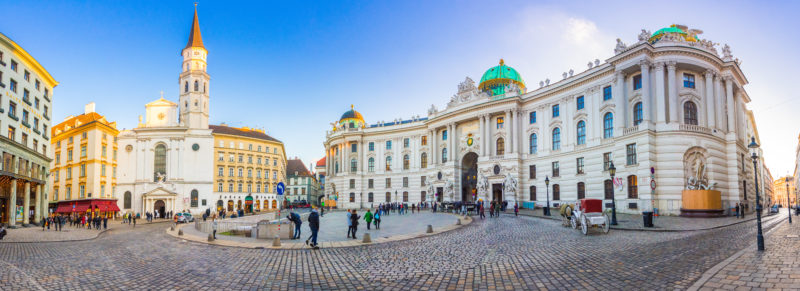
Wondering what to eat in Vienna? Use this first-timer’s guide to the top local food and drinks to discover in the Austrian capital…
For me, eating and travel go hand in hand! There’s just no better way to delve into a country’s culture than to taste it.
So of course, in between exploring all of Vienna’s beautiful palaces with my travel pal Lisa from Flåm Travel Guide, I made sure to eat as many local dishes as possible.
If you want to try all the most iconic food and drinks in Vienna, I’ve rounded up the top 12 must-try dishes, including the best mains, street food snacks, and sweet treats.
Vienna is also the only capital city which produces significant quantities of wine within the city limits. At the end of this post, I’ve also shared some Viennese wine varieties you should try in the city.
From decadent desserts to the iconic Wiener schnitzel, and from creamy coffees to crisp white wines, this is everything you have to eat and drink when you visit Vienna…
What is Viennese Cuisine?
Did you know that Viennese cuisine is the only cuisine named after a city and not a country?
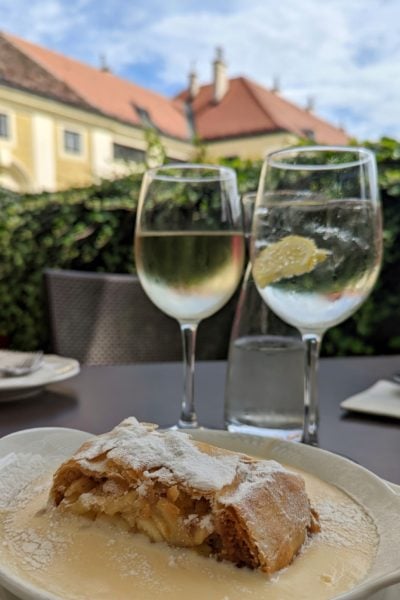
Vienna has been the capital of Austria for over 1000 years. As a result, Viennese cuisine has been influenced by the different regions that were once part of the monarchy – in particular, the Austro-Hungarian Empire (1867-1918).
Traditional Viennese cuisine is often quite heavy and hearty. Expect a lot of meat, potatoes, and cheese! But this is also a city with a legendary coffee house culture and a world of delicious desserts to try.
One of the reasons I loved Viennese cuisine so much is that the city is well-known for pastries and cakes! From the iconic strudel to the legendary Sachertorte, there are so many incredible sweet treats to discover in Vienna.
Pastries and desserts are often eaten a with a coffee in the afternoons. This is a tradition I was more than happy to indulge in while I explored Vienna – and I recommend you do too!
What to Eat in Vienna
1 – Wiener Schnitzel
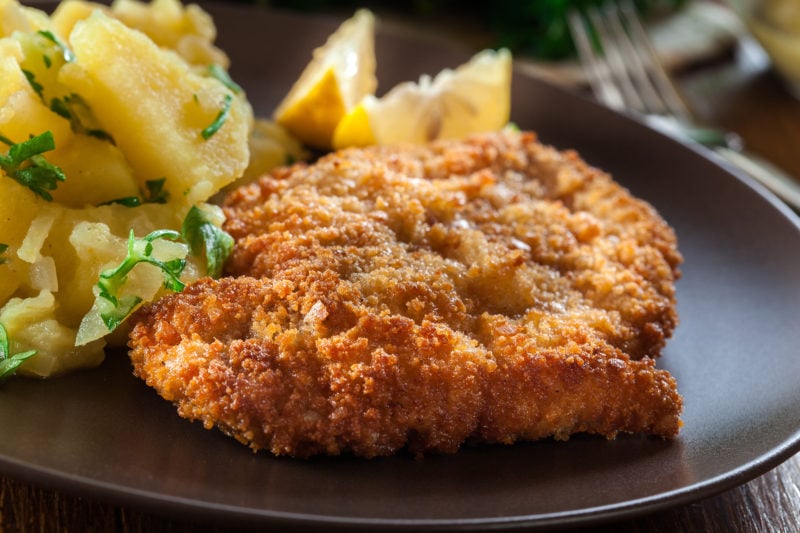
Austria’s national dish, and probably one of the country’s most famous worldwide, Wiener Schnitzel was born in the Austrian capital. Hence the name: Wiener=Vienna in Austrian.
Traditionally, Wiener Schnitzel is made using veal, but these days pork and chicken are also pretty common. The dish is made using a flattened piece of meat which is covered in breadcrumbs, then fried (usually in butter) until golden yellow.
Usually, the crispy-coated cutlet is served with a slice of lemon and parsley to garnish. The most common side dishes are potato salad or french fries.
You’ll find Wiener Schnitzel at restaurants all over the city, so it’s easy to try this tasty Austrian dish when you visit Vienna.
2 – Sachertorte
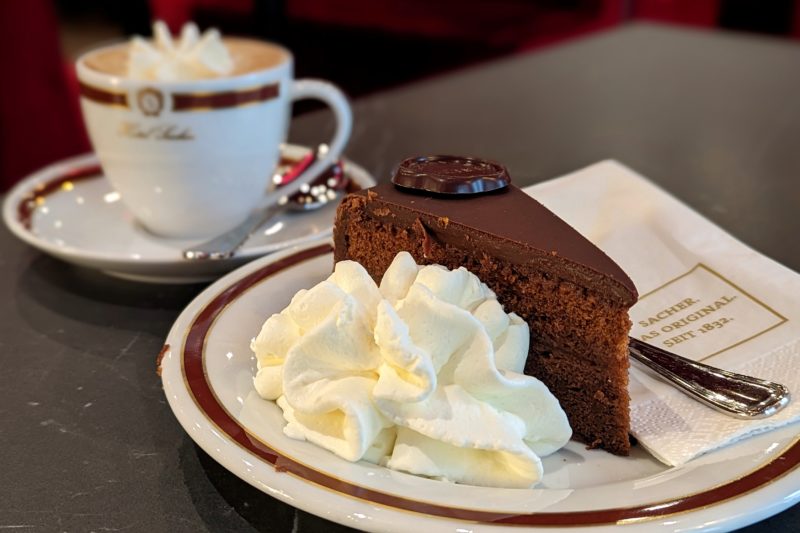
Anyone who follows me on social media has probably noticed I’m a BIG fan of desserts! So when I visited Vienna there was really only one food that was top of my list to try: sachertorte!
Sachertorte, or Sacher Torte, is a super-rich, decadent chocolate cake named after its inventor, Franz Sacher. According to the story, he created the dessert in 1832 for Prince Metternich, specifically to be served at a dinner for high-ranking guests in Vienna. Sacher’s son later opened the Hotel Sacher in 1876, which became famous as the “home” of the Sachertorte.
So what is Sachertorte? It’s a chocolate cake with two layers of dense chocolate sponge, with a thin layer of apricot jam in between. The whole thing is coated with thick chocolate icing, creating a perfectly smooth circle of rich chocolate deliciousness. A slice is usually served with a big dollop of whipped cream, and is best eaten with a cup of coffee.
Although you can try Sachertorte at cafes and bakeries all over Vienna, there’s really nowhere better to taste this piece of chocolatey heaven than at its home, Cafe Sacher Wien at the Hotel Sacher. The cafe here is a sumptuously glamorous space. Think crystal chandeliers and regal red trappings – perfect after a morning exploring Vienna’s beautiful palaces! Try to arrive early, as there’s often a queue out the door for seats.
LEARN MORE: Sweet Vienna Tour – Home of Cakes and Cafe Culture (from $30.32pp).
3 – Tafelspitz
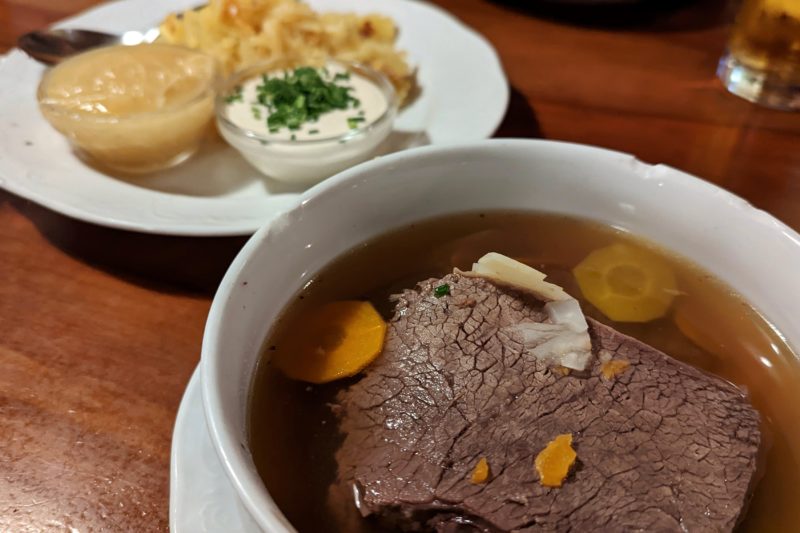
Another Austrian national dish and a staple of traditional Viennese cuisine is Tafelspitz. Supposedly, this was the favourite dish of Franz Joseph I, Emperor of Austria, so it’s definitely a meal you have to try when you’re in Vienna.
It’s a hearty, wintery meal with boiled beef or veal and root vegetables, served in a thin broth. The name comes from the meat cut used, which is what we call topside in the UK (or standing rump in the US).
Usually, tafelspitz is served with thinly sliced roast potatoes, as well as sour cream with chives. There’s also a really tasty sauce made from pureed apples mixed with slices of fresh horseradish. This fruity-but-hot sauce is the perfect accompaniment, as otherwise the meal would feel a little bland.
I tried tafelspitz at Reinthaler’s Beisl, a very cosy and friendly restaurant specialising in traditional Austrian food in Vienna city centre.
4 – Würstel
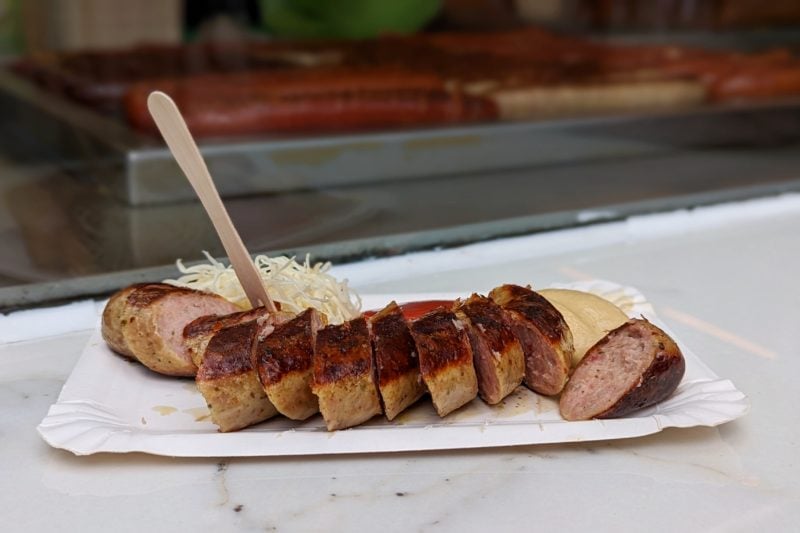
If you fancy a quick, hot snack whilst exploring (or bar-hopping) in Vienna, you can’t go wrong with a würstel!
Würstel just means sausages, but these are a super popular street food snack in Austria. Vienna is full of Würstelstands, which serve up hot grilled sausages either sliced, or in a crusty baguette (for a better version of a hot dog!).
Traditional Wiener Würstel is usually made from both beef and pork and wrapped in a sheep’s intestine. But there are a variety of options at most würstelstands, including bratwurst, frankfurter, and currywurst. Don’t miss the popular Käsekraine, a cheese-filled sausage.
5 – Käsespätzle
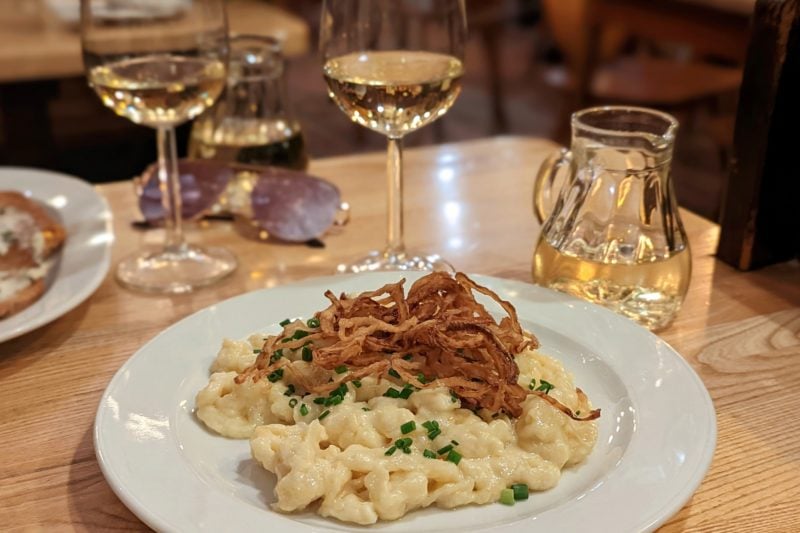
Käsespätzle isn’t actually a Viennese food but an Alpine dish which originated in Germany. However, it’s a very popular dish throughout Austria, and you’ll see it on menus all over Vienna.
I discovered käsespätzle on my trip to Vorarlberg a few years ago and fell in love – so I was delighted to find its pretty popular in Vienna too.
Also known as kasspatzln in Tyrol, käsespätzle are soft egg noodles or dumplings (spätzle), which are coated in cheese and baked. Sort of like an Austrian version of mac n’ cheese!
This gooey, cheesy pile of yumminess is topped with a sprinkling of fried onion. Simple, hearty, and definitely a must-try when you visit Austria.
READ MORE: Discover more alpine Austrian dishes in my Tyrol Food Guide.
6 – Austrian Goulash
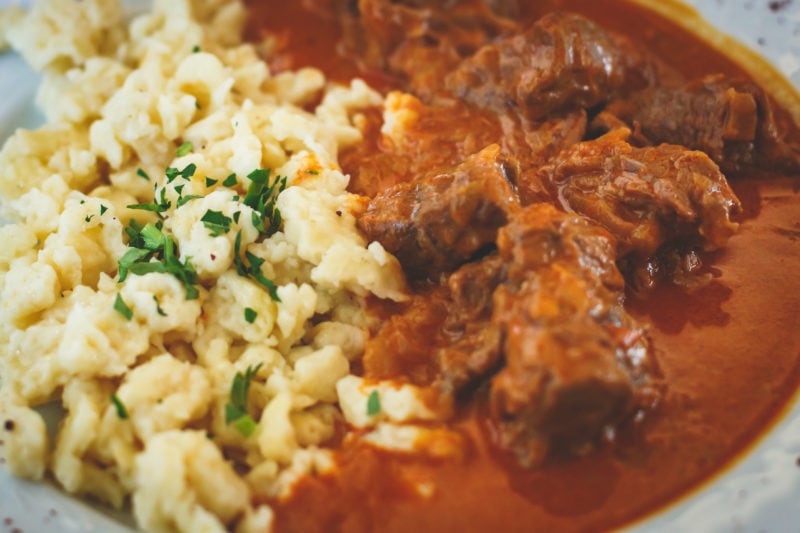
Goulash is traditionally a Hungarian dish, but Austria have their own version of this hearty meat stew, sometimes also called Wiener goulash.
Austrian goulash is traditionally made with beef and onions, in a tomato-based sauce flavoured with paprika. It’s generally quite a thick, rich sauce, unlike Hungarian goulash which is usually a little more soup-y.
The other difference between the two styles is that Hungarian goulash often contains bell peppers and/or potatoes, whereas in Austria the dish only contains beef and onions.
7 – Apfelstrudel (Apple Strudel)
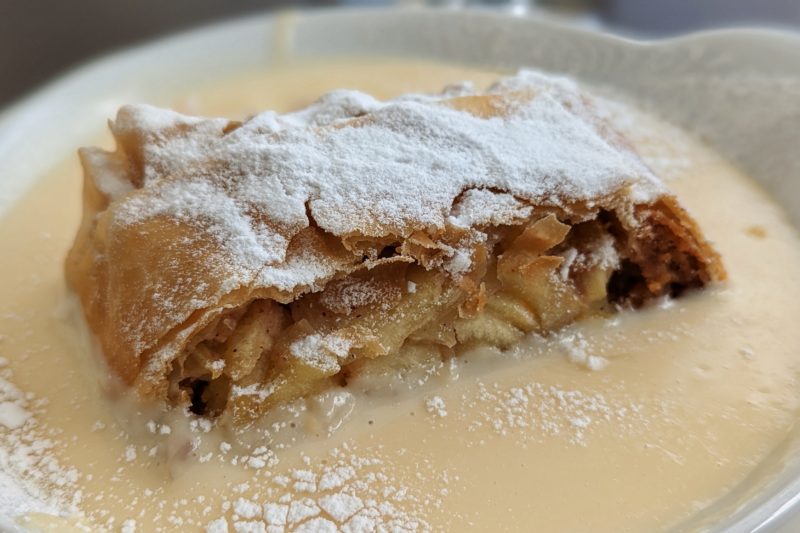
OK – time to get back to desserts! One Austrian dish that pretty much everyone is sure to have heard of is apfelstrudel – aka apple strudel.
Strudel is a dessert made from a very thin, delicate and flaky pastry rolled around a filling and baked. Usually, the filling is fruit, and the best-known version is apple strudel.
Fun fact; the name “strudel” comes from the German word for whirlpool or eddy, because of the swirled shape of the dessert once it’s cut open.
Although it’s very strongly associated with Austrian cuisine, strudel is thought to have been based on the Turkish baklava pastry, which was introduced into Austria in 1453. The oldest known strudel recipe was handwritten in 1696 – the original still exists at the Viennese City Library.
8 – Topfenstrudel (Cream Cheese strudel)
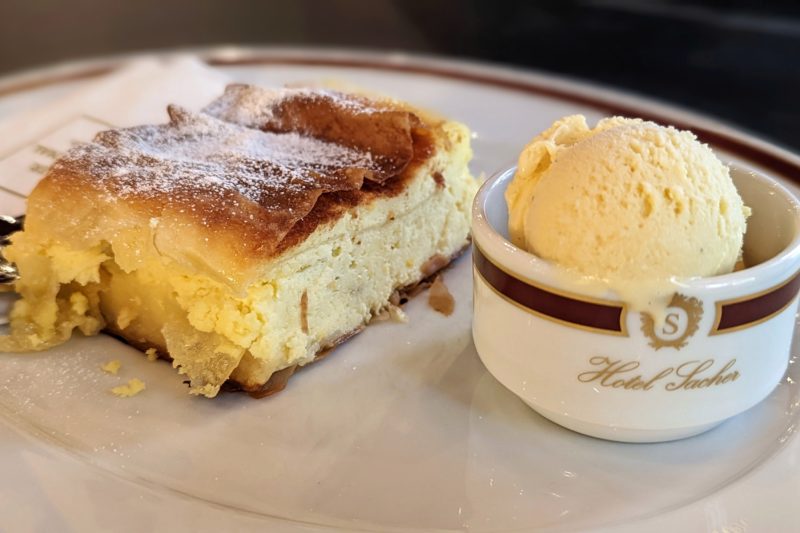
Another great strudel you have to try in Vienna is topfenstrudel – cream cheese strudel.
This rich and creamy Austrian dessert is made with the same delicate pastry as any other strudel. But the filling is made using sweetened curd cheese and raisins, creating an almost cheesecake-like flavour with a texture similar to the UK’s bread and butter pudding. Basically, it’s dense, creamy, and very, very tasty!
9 – Kaiserschmarrn
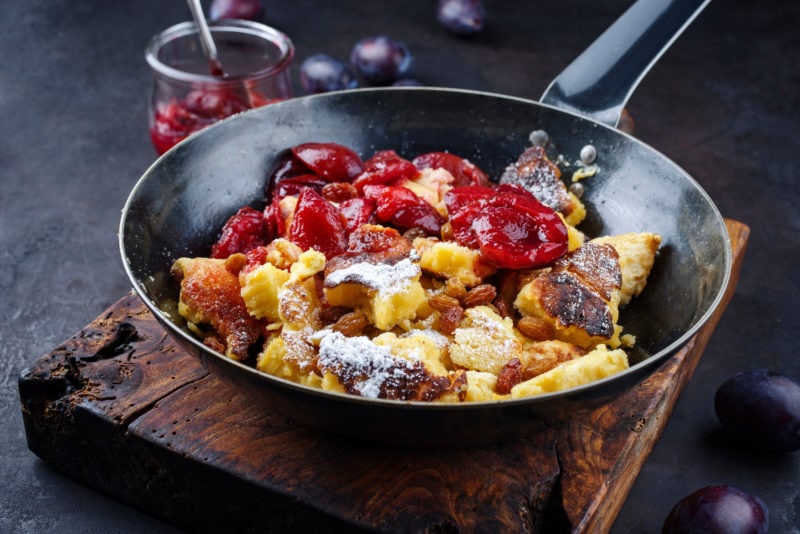
I discovered kaiserschmarrn on my trip to the Salzburgerland region of Austria last summer and couldn’t get enough of it.
Essentially, it’s a light, fluffy pancake made from a sweet batter (often with rum-soaked raisins added, according to the original recipe) which is then served shredded and dusted with powdered sugar.
Traditionally, the pancake chunks are served with a hot plum sauce. But you can also find it served with different fruit
This dessert is popular throughout Austria, as well as many parts of the former Austro-Hungarian empire. But it’s named after the Austrian emperor Franz Joseph I (kaiser = emperor), who lived in Vienna – so it’s a great dish to try after visiting his former residence at the Hoffburg Palace.
10 – Manner Wafers
Another sweet treat you absolutely HAVE to try in Vienna is Manner Wafers. But let me warn you, you probably won’t want to stop at just one!
I love these little wafer biscuits, which are like a hazelnut version of the UK’s Pink Wafers (a 90s children’s party classic).
This classic Viennese treat was invented in the 1890s by Viennese confectioner Josef Manner. The Original Neopolitan is the classic version: five layers of wafers filled with four layers of sweet hazelnut cocoa cream.
There are lots of new flavours and different variations today, but the classic is still the most popular – and a must-try food in Vienna.
In Vienna, you can visit the flagship Manner store on Stephansplatz to discover a vast range of different wafer varieties, as well as other confectionary and merch. But you can also buy Manner Wafers all over the city at supermarkets and newsagents.
11 – Punschkrapfen
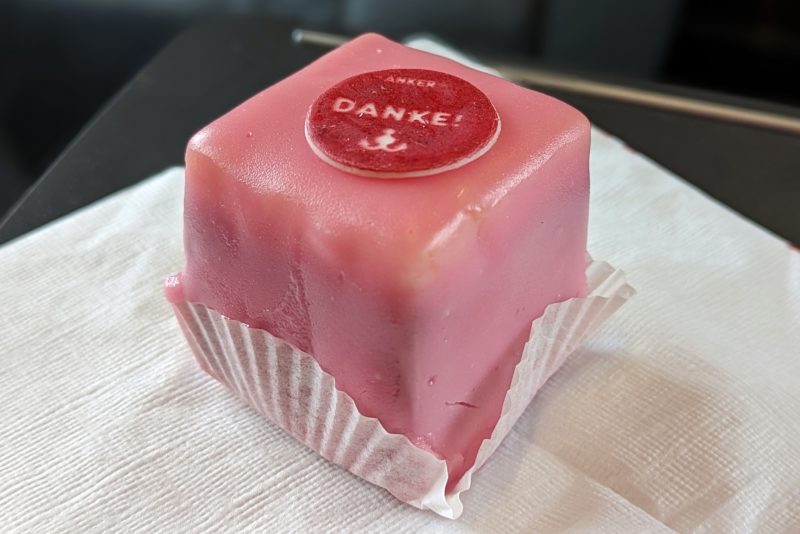
If you’re not done with sweet treats by now, there’s one more Austrian dessert you should try in Vienna. Punschkrapfen, or punch cake, is a Viennese classic that looks a little bit like a fancier version of my favourite cakes, Fondant Fancies!
It’s made from a super light sponge, filled with jam and soaked in rum. This is cut into small square cubes and coated with a bright pink punschglasur (punch glaze).
No one knows who invented the cake or how it arrived in Vienna, but it may date right back to the Middle Ages! You can find it at bakeries all over Vienna, although Original Wiener Punschkrapfen claim to make the OG version of this sticky, sweet pink cake.
12 – Viennese Coffee – Melange and More
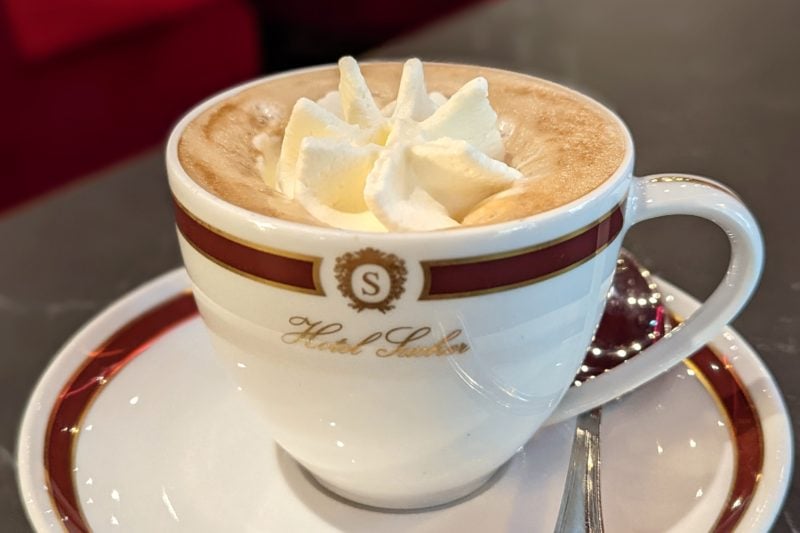
The Italians might be more famous for coffee, but in Vienna, coffee house culture has been raised to an art form.
In Vienna, the must-try drink is Wiener Melange. Similar to a cappuccino, but usually made with a milder coffee, this is a shot of espresso topped with hot milk and milk foam.
There are quite a few variants in coffee houses throughout the city. One of the most popular twists is to top the milk foam with whipped cream, sometimes called a Franziskaner.
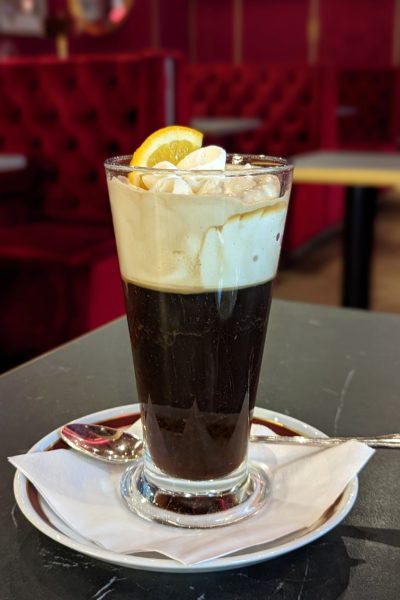
Another popular coffee drink is Kaffee Maria Theresia, named after the 18th-century Habsburg empress. It’s a double espresso shot, mixed with orange liqueur and topped with whipped cream. This makes for a decadent treat, but it was a bit too boozy for me!
LEARN MORE: Guided Viennese Coffee-House Tour (from $62.67pp)
Austrian Wines to Drink in Vienna
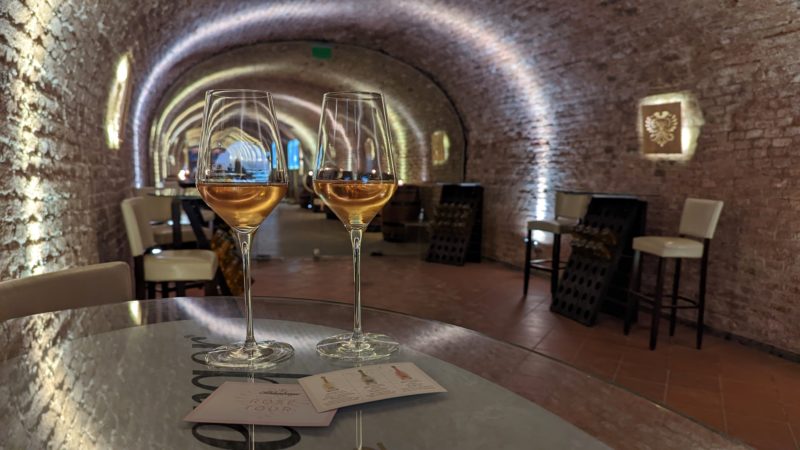
With over 700 hectares (1,680 acres) of urban vineyards, Vienna is the only capital in the world to produce so much wine within the city limits. And Viennese wine is now counted among the best in the world.
Many of Vienna’s wineries and vineyards can be reached by tram, or even on foot, from the city centre. So be sure to visit one for a tour and tasting to learn a little more about Viennese wine.
LEARN MORE: Local Wine Tasting in a Historic Roman Wine Cellar, from $29.31pp.
Gruner Veltliner
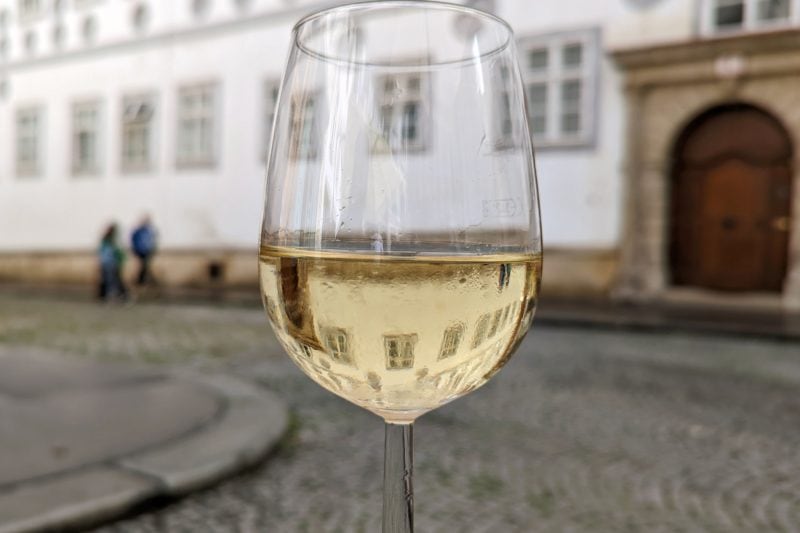
The vineyards around Vienna mainly cultivate white grapes, and the local variety Grüner Veltliner is the most common. This is a must try drink when you visit Vienna.
This is a dry white wine which is perfect paired with local dishes like Wiener Schnitzel. According to Wine Folly, Grüner Veltliner is light and tangy when young, but becomes richer when aged.
You’ll see Grüner Veltliner on the wine list at almost every restaurant and bar in the city. My favourite was Vienna’s smallest wine bar, Vis a Vis, a friendly and cosy little bar with a great atmosphere. Check out this list of the best wine bars in Vienna to find your ideal spot.
Welschriesling
The other main grape variety found around Vienna is Welschriesling. Unrelated to the better known Rhine Riesling, Welschriesling is known for being fresh and neutral, which makes it a very easy-drinking dry white wine.
Welschriesling is less common than the better-known Grüner Veltliner, but be sure to keep an eye out for it. We tried it at The Gloriette at the Schönbrunn Palace – worth a visit for the views alone!
“Champagne” Tasting at Schlumberger
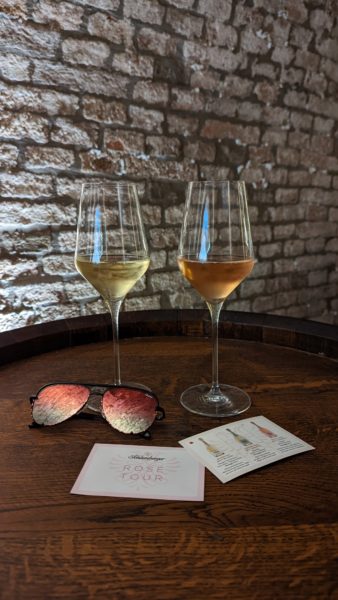
Vienna is on the same latitude as the champagne region in France. So it’s no surprise that sparkling wine from this region is remarkably similar to champagne.
Sparkling wine fans should head to Schlumberger Kellerwelten in Vienna. Founded in 1842, they make their sparkling wine according to the champagne method. Only the location of the vineyard keeps this delicious bubbly from being champagne!
Tour Vienna’s oldest champagne cellar (the vaults are around 300 years old) and enjoy a tasting – without having to leave the city centre! A tour with three glasses of champagne starts from just 16 euros.
CLICK HERE to check prices and availability for your visit.
Other Vienna Restaurants
If you fancy a change from traditional Viennese cuisine, there are plenty of fab restaurants all over Vienna offering all kinds of other food. These were a couple of my favourite finds:
Reserva Ibérica – for Spanish-inspired tapas, wine, and sangria.
Ristorante Fratelli – for delicious Italian food and a great wine list. Order the truffle pasta if it’s on the menu!
Vienna Food Tours
If you want to learn more about Viennese cuisine, or try local food with an expert guide, these Vienna food tours are perfect…
- Naschmarkt Food Tasting Tour
- Wine Tasting at Traditional Cellar
- Food, Coffee, and Market Discovery Tour
- 3-Course Dinner and Concert at Schönbrunn Palace
- Wachau Valley Winery Biking Tour
READ MORE: Austria Solo Female Travel Guide
So, this was my guide to what to eat in Vienna! If you have any more great recommendations for traditional Viennese dishes and drinks – or any must-visit restaurants – let us know in the comments below…


